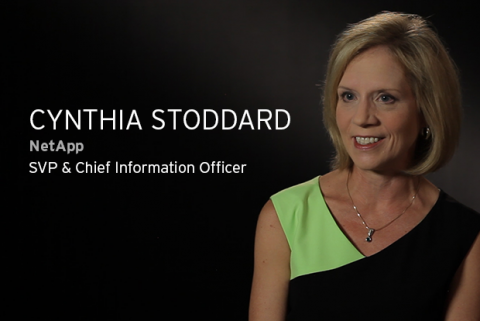Submitted by Cynthia Stoddard, Senior Vice President and CIO of NetApp
Retaining star performers – or even up-and-coming talent – is a huge challenge in IT today. If you’re in Silicon Valley, as I am, the challenge can feel even tougher. Having worked in the insurance, transportation, logistics, retail, and high-tech industries, I’ve seen a lot of things work when it comes to keeping people engaged, interested, and committed to the company. In general everyone wants to do a good job, but it never hurts to direct that energy. Here are five actions you might consider for your organization:
1. Define and share a direction people can follow.
I’ve seen it over and over: if people feel that their company has a focused direction, they believe they can make a contribution there. If you can give them the guardrails and the direction then it makes it a more productive place where people can enjoy more of what they’re doing. If you haven’t verbalized that direction recently, it might be time to revisit it.
2. Co-create.
The concept and techniques of co-creation mean that great thinking can come from all levels of the organization. At NetApp, we’ve adopted some of the work that Dr. John Kotter has done with the Guiding Coalition to pull ideas and initiatives from all levels including individual contributors. And we empower them to come forward and initiate change within the organization. All of that helps with retaining high performers.
3. Make time for information exchange.
I run coffee talk sessions regularly with small groups of people we bring together, where they can ask me any question on their mind and I share information back to them. We also have brown bag lunches where we talk about various topics and be very targeted on how we should approach challenges in running IT.
If you hold these talks or lunches you should be prepared for questions that range from your BYOD strategy to how you maintain your work/life balance. I recently had someone ask: “You’re a CIO. Early in your career how did you make sure that your kids got home from school?” Then the next question was about what I thought about the products and services we’re bringing to the market. People want to talk about everything, so be prepared for it, and be open and transparent.
4. Create a failure-free zone.
It’s important to give talented employees new opportunities and allow them to stretch themselves. At NetApp we have an Innovation Zone where people can try out new ideas. This is both a physical space within the IT organization and a virtual place online. We have a lab for the technology components so we can dry-run different products and ideas. And virtually people can share ideas through our intranet, which we call our IT Front Door.
It’s important that people can fail fast with something that isn’t going to work out or try a new idea and then bring it forward. Our Innovation Zone is actually where our cloud initiatives were born. And people can share ideas not only on the technology side but also on the process side.
5. Don’t just let people participate: get them to present.
It’s important to allow people to participate in a variety of initiatives and then have them present those ideas. At NetApp we give them the ability to present to my staff so they get to try out some of their public speaking skills. And they get the visibility in front of the executive staff. That helps out, too, because people are growing when they do those sorts of things.
What I’ve done is have people come in and present to me first and give them feedback and guidance, so when they get into the room in front of the executive staff, they can understand some of the personalities they’ll be presenting to and anticipate questions they may get from the audience. They learn that sometimes fewer words are more powerful than more words. People tend to want to share everything they know and sometimes you get lost in the details. When you’re presenting to your peers in a technical group it’s much different than presenting to an executive, because they’re interested in the headlines, such as the risk aspects and the financial aspects.
Cynthia Stoddard is the senior vice president and CIO at NetApp. In her role as CIO, she is responsible for providing a long-term technology vision that supports and is aligned with the company’s strategies and goals, business plans, operating requirements, and overall efficiencies. She has over 25 years of business experience and IT expertise leading large global organizations in supply chain, retail, and technology companies.




